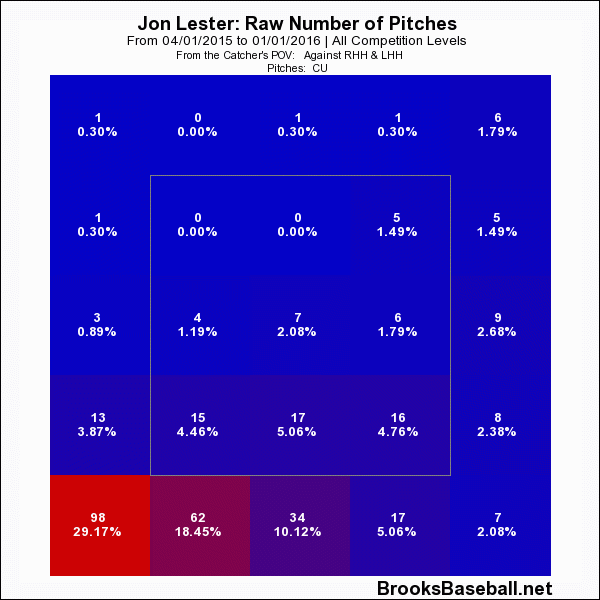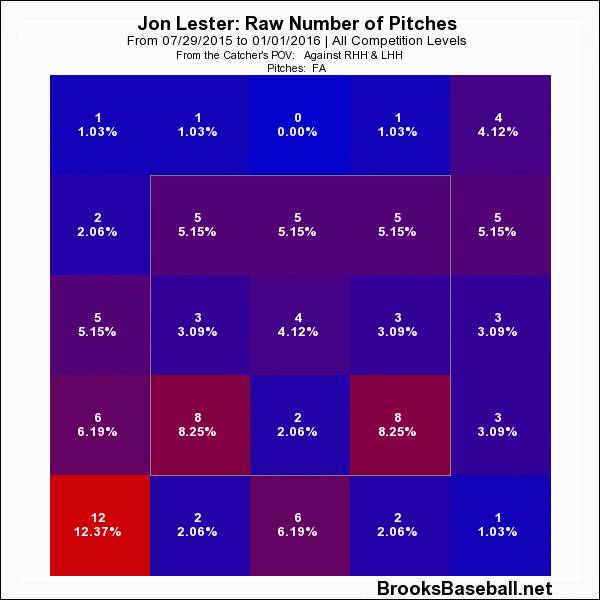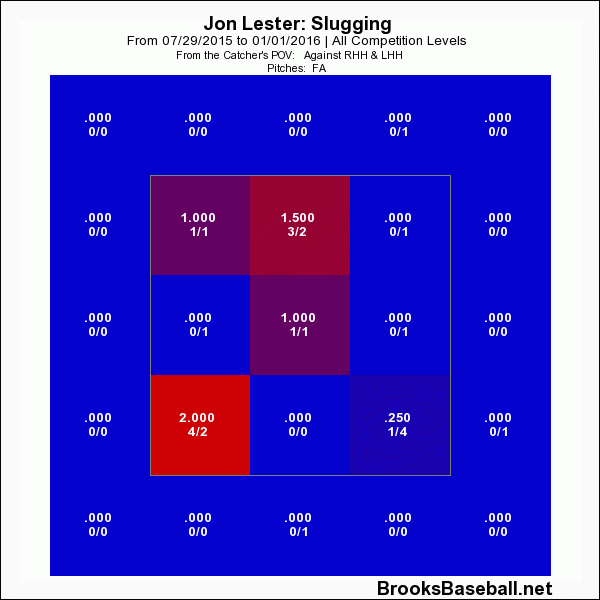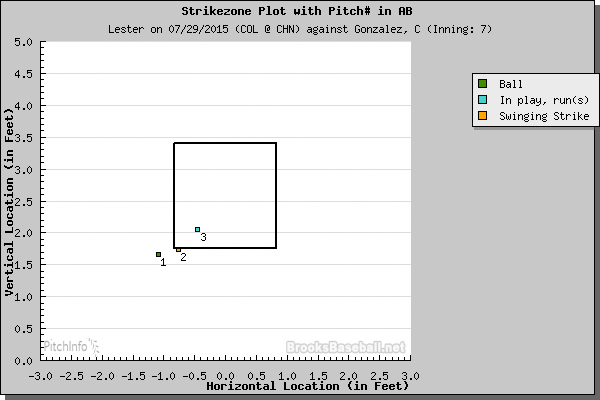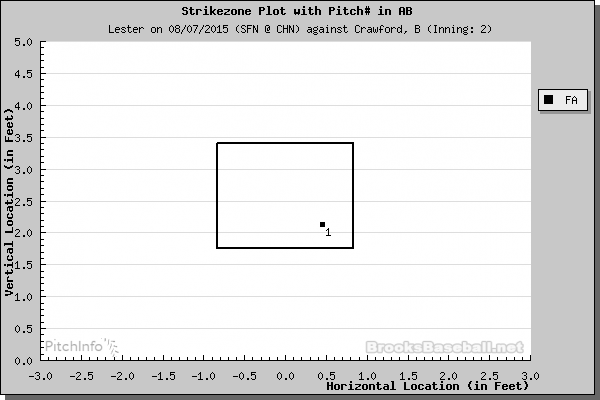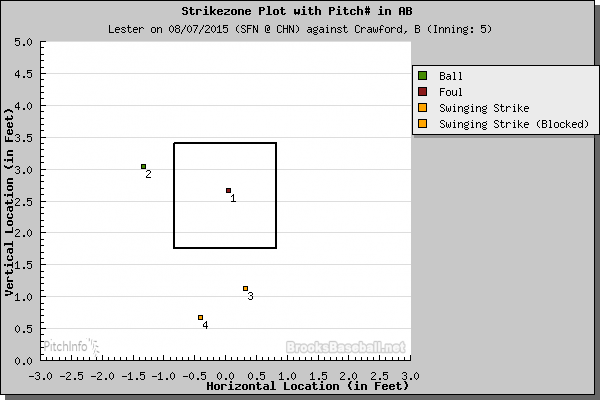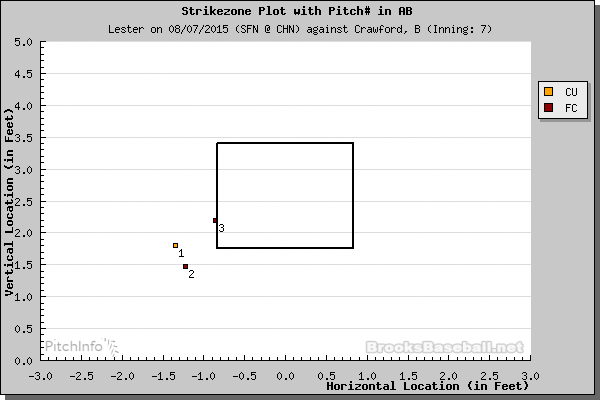Date: August 7, 2015
Opponent: San Francisco Giants
Location: Wrigley Field
Introduction
On Friday afternoon, with a playoff atmosphere permeating the sold-out Friendly Confines from the first pitch, Jon Lester took the ball against one of the National League’s best offenses. There are just two words to describe the type of start Lester delivered against the San Francisco Giants: G**damn professional. Lester was efficient and battled through a few jams, despite not having overpowering stuff. He has now gone at least seven innings in seven consecutive starts, which is one game shy of his career-best eight consecutive starts in July and August of 2008.
As we said, Lester did not have his best swing-and-miss stuff, inducing just three strikeouts and eight whiffs on the afternoon. It was his lowest strikeout total of the season. Lester’s two induced whiffs came on pitches in the strike zone and Giants batters took 11 called strikes on pitches in the strike zone. Lester was the victim of some well-placed batted balls, as both of Buster Posey’s hits somehow dropped in.
What Lester did do well was induce 13 groundballs, his third highest total of any start in 2015. Lester was also efficient with his pitches. He needed more than 14 pitches in just one inning (see Key At-Bat section), and he required just 50 pitches to retire 12 of 13 batters in innings two through six. Lester appeared to be pitching to contact. He got ahead of 62 percent of batters (16 of 26), just above his season average.
Lester’s low-strikeout total should not be a complete shock, as the Giants 18.1 percent strikeout rate is the best in the National League. The Giants entered the game as one of the National League’s best offenses, ranking among the top three in the NL in runs scored, doubles, triples, on-base percentage, slugging percentage, OPS, and BABIP. They had been especially hot in the preceding week, averaging six runs per game in their last six contests.
However, despite being one of the NL’s top offenses, the Giants, like Lester’s previous opponent, the Colorado Rockies, have struggled against left-handed pitchers—hitting just .262/.319/.369. Those problems continued against Lester.
On Friday, Lester was very good against one of the league’s best offenses. He was economical with his pitch count, worked through a few Giants rallies, and just as importantly, he got some run support—finally (see Trends section). With the rollicking Wrigley crowd behind Lester on each pitch, and the Cubs bats doing more than enough damage, Lester delivered. Keep reading below to relive Friday’s party in Wrigleyville.
Traditional Line
7.0 IP, 6 H, 3 K, 2 BB, 2 ER
Pitch Breakdown
100 pitches (60 strikes)
| Total | Velocity (Max) | AVG | SLG | BABIP | |
| Four-Seam | 35 | 93.0 (94.9) | .429 | .571 | .429 |
| Cutter | 27 | 88.7 (91.5) | .167 | .167 | .200 |
| Sinker | 15 | 92.1 (94.4) | .000 | .000 | .000 |
| Change-Up | 3 | 85.5 (85.9) | 1.000 | 2.000 | 1.000 |
| Curveball | 20 | 75.4 (78.9) | .000 | .000 | .000 |
Lester went to his curve with his greatest frequency (20.0 percent) since May 16 against the Pittsburgh Pirates. Against the Giants, Lester used the curve to induce two of his eight whiffs, and one of his three strikeouts. On the season, opposing batters have just a .222 slugging percentage and 50.7 percent strikeout rate against the curve. It remains his most consistent and effective pitch this season. Perhaps not coincidentally, in 2015, Lester has done an exceptional job of keeping his curve down:
This season, Lester has kept his curve down and surrendered just four extra-base hits off a pitch he throws nearly 16 percent of all pitches. As far as a number-three pitch goes, it has been remarkably effective for Lester.
The Giants did most of their damage against Lester’s four-seam fastball. While he went to the four-seamer just 35 percent of all pitches—six percentage points below his season average and his lowest usage rate since the All-Star break—Lester surrendered three of his six hits. He also failed to record a strikeout on the pitch for the first time all season. It was the second consecutive start in which the four-seamer was Lester’s least effective pitch (see Trends section).
While his four-seamer was not sharp, Lester’s other fastballs were effective. Combined, Lester picked up 11 of 21 outs from the sinker and cutter. At 15 percent, Lester went to his sinker at his greatest frequency since June 25th against the Los Angeles Dodgers. On the season, Lester has gone to his sinker 11.8 percent of all pitches, an increase of four percentage points from last season, and with opposing batters slugging .329, he is seeing his best results on the pitch in a half-decade.
Trends
As we detailed in last week’s Ballad, Lester found success with all of his pitches in July—high strikeout totals, low walk totals, and few extra-base hits. While this trend mostly continued in his first August start, Lester did experience minor struggles with his four-seam fastball. In fact, in his past two starts against the Rockies and Giants, Lester has run into some difficulties with his four-seam fastball. In the two games, opposing batters are hitting .375/.444/.625 against the pitch.
Left-handed batters, in particular, have had success, hitting .571 and slugging 1.000 against his four-seamer. In 2015, left-handers have slugged .725 against four-seamers, with the only three home runs he has surrendered to left-handed batters. Lester has been keeping his four-seamers low and away from left-handed batters:
However, when he has left four-seamers up and over the plate in his past two starts, batters have made him pay:
This includes Carlos Gonzalez’s home run on July 29th on a 93 mph four-seamer that caught too much of the plate:
Lester experienced similar difficulties early in the season, leaving four-seamers over the plate and dealing with the consequences, but he made improvements. From June 10th through July 28th, a span of eight starts, left-handed batters hit just .200 and slugged .267 against Lester’s four-seam fastball. Considering Buster Posey’s double off a four-seam fastball was a bloop to shallow right-field, there is every reason to expect the inflated numbers against Lester’s primary pitch to be a mini-trend.
Key At-Bat/Sequence
Inning: Seventh
Score: 6-2, Cubs
Situation: Hunter Pence on first base, Buster Posey on second base
Batter(s): Brandon Crawford
Lester needed just 72 pitches to get through the first six innings, and appeared to be cruising after needing just nine pitches to get through the sixth. However, just three batters into the seventh inning, Lester was in trouble.
Lester opened the inning by walking Matt Duffy after pushing the count full, making it his first start with multiple walks since July 6th against St. Louis. After an opposite-field bloop single by Buster Posey and a base hit by Hunter Pence brought across the Giant’s second run, Lester had to face Brandon Crawford with runners on first and second , and the tying run now in the on-deck circle.
Crawford entered the day hitting .263/.324/.492, and a more-than-solid .267/.306/.456 against left-handed pitchers. In Crawford’s first at-bat, Lester tried to hit the inside corner with 93 mph four-seamer:
The pitch caught a bit too much of the plate, though, and Crawford pulled the ball through the hole on the right side for a RBI single.
In Crawford’s second at-bat, Lester picked up a strikeout by going to his four-seamer, cutter, sinker, and curve:
After setting him up with three fastballs, Lester got the punchout by getting Crawford to whiff at a 75 mph curve at his ankles.
Lester and Ross must have filed away the at-bat, because when Crawford came to the plate in the seventh-inning, they started him with a curve, inducing another whiff for strike one. On 0-and-1, Lester stayed low and away with a 90 mph cutter, and Crawford whiffed for strike two.
On 0-and-2, Lester went back to the 90 mph cutter on the outside corner:
This time Crawford hit a one-bouncer back to Lester, who began a 1-6-3 double play, aided by Addison Russell’s incredibly skillful and acrobatic turn at second base.
The pitch selection was perfect, as Crawford entered the game hitless against cutters from left-handed pitchers in 2015, and slugging just .147 with one extra-base hit in his entire career. Lester had also learned his lesson from Crawford’s first at-bat, and stayed away from the inner-half of the plate in his next two at-bats. On the day, three of Lester’s eight whiffs came against Crawford.
After a walk to Brandon Belt, Lester battled Ehire Adrianza for eight pitches, before finally inducing a pop out to Anthony Rizzo. Lester’s afternoon was done after requiring 28 pitches to get through the inning.
Keep-In-Mind
On a beautiful, sunny Friday on the North Side, there was more than just the weekend and a playoff spot to celebrate. For on this day, the Cubs scored runs, real honest-to-goodness runs, with Lester on the mound. The offense had not scored more than four runs in a Lester start since May 6th at St. Louis. In fact, the team’s five-run sixth-inning alone stands as their fourth highest output in Lester starts in 2015. At 2.91 runs per game, Lester is still receiving the NL’s third-lowest run support.
Conclusion
Lester remains on an absolute roll. The Giants threatened against Lester, but he was able to locate his cutter, sinker, and curve to induce weak ground balls and pop flies at opportune moments. Against one of the NL’s top offenses, Lester was efficient and in control. In his last 10 starts, dating back exactly two calendar months, Lester has posted a 2.12 ERA, 0.89 WHIP, 27.0 percent strikeout rate, 5.5 percent walk rate, and a .533 OPS. The season’s final third is underway and Jon Lester is looking every bit the staff ace for a team whose playoff aspirations grow more realistic by the day. This is getting pretty fun, huh?
Season to Date
7-8, 3.22 ERA (4.07 DRA), 1.167 WHIP, 24.3% K, 6.0% BB
Lead photo courtesy of Caylor Arnold-USA TODAY Sports

